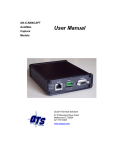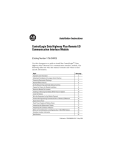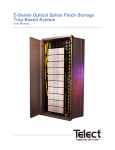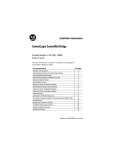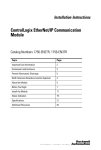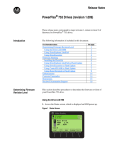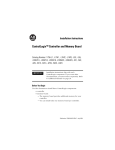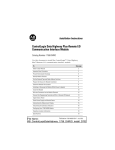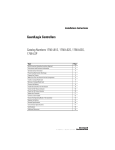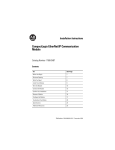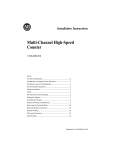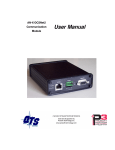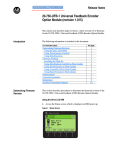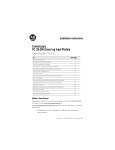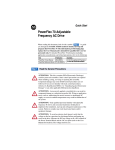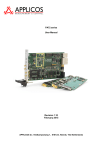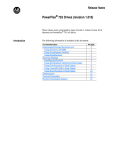Download Installation Instructions - Kirby Risk Electrical Supply
Transcript
Installation Instructions ControlLogix AutoMax DCSNet and AutoMax Remote I/O Communication Interface Module (Catalog Number 56AMXN/B) Use this document as a guide to install the ControlLogix AutoMax DCS and AutoMax Remote I/O communication interface module. The following table lists what this manual contains and where to find specific information. Topic See Page Important User Information 2 Understand Compliance to European Union Directive 4 Preventing Electrostatic Discharge 5 Identify Module Features 6 Set the Network Type and Drop Address Switches 7 Prepare the Chassis for Module Installation 8 Determine Module Slot Location 9 Install the Module 11 Wire the Module for the AutoMax Network 13 Apply Chassis Power 14 Interpreting the Alphanumeric Display 15 Interpreting the LED Status Indicators 17 Specifications 21 Support 22 Publication 56AMXN-IN002A-EN-P November 2002 2 DCSNet/RE RIO Module Important User Information Because of the variety of uses for the products described in this publication, those responsible for the application and use of this control equipment must satisfy themselves that all necessary steps have been taken to assure that each application and use meets all performance and safety requirements, including any applicable laws, regulations, codes and standards. The illustrations, charts, sample programs and layout examples shown in this guide are intended solely for purposes of example. Since there are many variables and requirements associated with any particular installation, Rockwell Automation does not assume responsibility or liability (to include intellectual property liability) for actual use based upon the examples shown in this publication. Allen-Bradley publication SGI-1.1, Safety Guidelines for the Application, Installation and Maintenance of Solid-State Control (available from your local Rockwell Automation office), describes some important differences between solid-state equipment and electromechanical devices that should be taken into consideration when applying products such as those described in this publication. Reproduction of the contents of this copyrighted publication, in whole or part, without written permission of Rockwell Automation, is prohibited. Publication 56AMXN-IN002A-EN-P November 2002 DCSNet/RE RIO Module 3 Throughout this manual we use the following notes to make you aware of safety considerations: Identifies information about practices or circumstances that have the potential to create an explosion hazard. Identifies information about other practices or circumstances that can lead to personal injury or death, property damage or economic loss. Warning and Attention statements help you to: • identify a hazard • avoid a hazard • recognize the consequences We use the following note to call attention to critical information: Identifies information that is critical for successful application and understanding of the product. Publication 56AMXN-IN002A-EN-P November 2002 4 DCSNet/RE RIO Module Understand Compliance to European Union Directive If this product bears the CE marking, it is approved for installation within the European Union and EEA regions. It has been designed and tested to meet the following directives. EMC Directive This product is tested to meet Council Directive 89/336/EEC Electromagnetic Compatibility (EMC) and the following standards, in whole or in part, documented in a technical construction file: • EN 50081-2 EMC - Generic Emission Standard, Part 2 - Industrial Environment • EN 50082-2 EMC - Generic Immunity Standard, Part 2 - Industrial Environment This product is intended for use in an industrial environment. Low Voltage Directive This product is tested to meet Council Directive 73/23/EEC Low Voltage, by applying the safety requirements of EN 61131-2 Programmable Controllers, Part 2 Equipment Requirements and Tests. For specific information required by EN 61131-2, see the appropriate sections in this publication, as well as the following Allen-Bradley publications: • Industrial Automation Wiring and Grounding Guidelines, publication 1770-4.1 • Automation Systems Catalog, publication B113 Open style devices must be provided with environmental and safety protection by proper mounting in enclosures designed for specific application conditions. See NEMA Standards publication 250 and IEC publication 529, as applicable, for explanations of the degrees of protection provided by different types of enclosure. Publication 56AMXN-IN002A-EN-P November 2002 DCSNet/RE RIO Module 5 Enclosure and Environmental Requirements Specific To This Product The 56AMXN/B is NOT suitable for use in hazardous locations. This product must be mounted within a suitable system enclosure to prevent personal injury resulting from accessibility to live parts. The interior of this enclosure must be accessible only by the use of a tool. This industrial control equipment is intended to operate in a Pollution Degree 2 environment, in overvoltage category II applications, (as defined in IEC publication 664A) at altitudes up to 2000 meters without derating. Preventing Electrostatic Discharge The 56AMXN/B module is sensitive to electrostatic discharge. Electrostatic discharge can damage integrated circuits or semiconductors if you touch backplane connector pins. Follow these guidelines when you handle the module: • Touch a grounded object to discharge static potential • Wear an approved wrist-strap grounding device • Do not touch the backplane connector or connector pins • Do not touch circuit components inside the module • If available, use a static-safe work station • When not in use, keep the module in its static-shield packaging For additional information refer to publication 1770-4.1, Industrial Automation Wiring and Grounding Guidelines. Publication 56AMXN-IN002A-EN-P November 2002 6 DCSNet/RE RIO Module ATTENTION Identify Module Features Refer to the following figure to identify the hardware components of the 56AMXN/B module. DCSNet / RE RIO XXXX NET CLX OK Network The module has: • A label to indicate that it is a scanner for AutoMax DCSNet and remote I/O • A 4-character scrolling display (XXXX) • 3 LEDs, labelled NET, CLX, and OK, to indicate the status of the network, the connection to the ControlLogix processor, and its own internal state • a 9-pin D-shell connector to connect to the DCS or remote I/O network • switches at the top of the module to set the mode of operation and the drop number and drop depth Publication 56AMXN-IN002A-EN-P November 2002 DCSNet/RE RIO Module 7 Set the Network Type and Node Address Switches Before you install the module, you must set the network type, drop number and drop depth using the switches at the top of the module. The two switches at the left set the drop depth, the two at the right set the drop number. The following table shows how to set the switches for each mode of operation. Depth 10 Depth 1 Drop 10 Drop 1 DCS Master 0 0 0 0 DCS slave Drop depth 10’s digit Drop depth 1’s digit Drop Number 10’s digit Drop number 1’s digit Remote I/O Master 0 1 0 0 For example, to configure the 56AMXN/B as a DCS slave with drop number 17, drop depth 5, set the switches to 0, 5, 1, and 7 from left to right. Any other settings are invalid and result in the module going into “Thumbwheel test” mode. In thumbwheel test mode, the display shows the current switch settings. It doesn’t go out of thumbwheel test mode until you cycle power. In thumbwheel test mode, the 56AMXN/B initially displays “Thumb Test Mode” on the 4-character display, displays the switch settings for 5 seconds, then resumes displaying “Thumb Test Mode” For DCS slave operation, if the drop number and drop depth are individually valid but the combination results in invalid drop numbers (for example, drop number 55, drop depth 2), the module displays an error message on the 4-character display but does not enter Thumbwheel test mode. Publication 56AMXN-IN002A-EN-P November 2002 8 DCSNet/RE RIO Module Prepare the Chassis for Module Installation Before you install the 56AMXN/B module, you must install and connect a ControlLogix chassis and power supply. For information on installing these products, refer to the publications listed in the following table. Chassis Type Chassis Power Power Supply Installation Supply Installation Series B: 1756-A4, -A7, Pub. No. 1756-PA72/B Pub. No. -A10, -A13 1756-IN080 1756-PB72/B 1756-5.67 1756-PA75/A Pub. No. 1756-PB75/A 1756-5.78 Publication 56AMXN-IN002A-EN-P November 2002 DCSNet/RE RIO Module 9 Determine Module Slot Location The figure below shows chassis slot numbering in a 4-slot chassis. Slot 0 is the first slot and is always the leftmost slot in the rack (the first slot to the right of the power supply). You can use any size ControlLogix chassis and install the module in any slot. You can also install multiple 56AMXN/B modules in the same chassis. You can install as many modules as your power supply can accommodate (i.e., number for which the power supply is rated). Publication 56AMXN-IN002A-EN-P November 2002 10 DCSNet/RE RIO Module Installing or Removing the Module While Power Is Applied Versions of the 56AMXN hardware prior to O-57677-1 do NOT support removal and insertion under power. The hardware version can be identified by looking for a sticker with the part number O-57677-1 or above on the module’s printed circuit (near the serial number – you do not need to disassemble the 56AMXN to find the sticker). Modules with no stickers are hardware version O-57677 and do NOT support removal and insertion under power For hardware versions O-57677-1 and above, you can install or remove the module while chassis power is applied if you observe the following precautions. When you insert or remove a module while backplane power is on, an electrical arc may occur. An electrical arc can cause personal injury or property damage by: • sending an erroneous signal to your system’s actuators causing unintended machine motion or loss of process control. • causing an explosion in a hazardous environment. Repeated electrical arcing causes excessive wear to contacts on both the module and its mating connector. Worn contacts may create electrical resistance that can affect module operation. Publication 56AMXN-IN002A-EN-P November 2002 DCSNet/RE RIO Module 11 Install the Module Do not force the module into the backplane connector. If you cannot seat the module with firm pressure, check the alignment. Forcing the module into the chassis can damage the backplane connector or the module. Publication 56AMXN-IN002A-EN-P November 2002 12 DCSNet/RE RIO Module Removing or Replacing the Module (When Applicable) If you are replacing an existing module with an identical one, and you want to resume identical system operation, you must install the new module in the same slot. You must also set the switches to the same settings and run the configuration program and download the appropriate configuration to the module. Publication 56AMXN-IN002A-EN-P November 2002 DCSNet/RE RIO Module 13 Wire the Connector for the AutoMax Network Use a drop cable, 612574-36R, available through Rockwell Automation Systems Business, and passive tap M/N 57C380 to connect the module to the coaxial network cable. This cable turns down and has a ferrite to reduce EMI. This cable must be used in CE applications. You can also use drop cable 612403-036R but it points up. The drop cable is a 3-foot long multi-conductor cable with 9-pin D-shell connectors at each end. Connect one end to the connector on the module and the other end to the passive tap. The passive tap has two BNC connectors for connection to the coaxial cables and terminating loads. The network coaxial cable must be terminated with 75 ohm terminating loads attached to the taps at the physical ends of the network. There should be two and only two terminators on the network. For DCS, the network cable can be RG-59/U or RG-11/U. For remote I/O, the cable must be RG-59/U. Apply Chassis Power Turn the rack power supply on. Publication 56AMXN-IN002A-EN-P November 2002 14 DCSNet/RE RIO Module Check Power Supply and Module Status The rack power supply indicator should be green. The module OK LED should be solid red, then solid green. The alphanumeric display shows the following messages at powerup. Alphanumeric Status Display Powerup Messages B#nn Stages in the startup processes Boot 56AMXN Ver 1.xx.xx Module firmware version Troubleshooting the Power Supply If the alphanumeric indicator on the 56AMXN/B module does not cycle through these messages on powerup, refer to the following table and to the Troubleshooting section that follows. Power Supply Indicator If the POWER indicator is: Off Power Supply Status is Recommended Action: Not operating Turn power switch ON. Check power wiring connections. Check fuse. On Operating Publication 56AMXN-IN002A-EN-P November 2002 None, normal operation. DCSNet/RE RIO Module 15 Interpreting the Alphanumeric Display The 56AMXN/B module displays alphanumeric messages that provide diagnostic information about your module. The alphanumeric display displays warning messages twice, then resumes the normal display. The following table summarizes the messages. Message Description 56AMXN Ver x.xx.xx The module’s firmware version, displayed at powerup. Error: Heard Another DCS Master The module is configured as a DCS master and has heard another DCS master on the network. DCS Master The module is a DCS master. Displayed during normal operation. Drop xx OffLine DCS drop xx has gone offline. DCS Slave Invalid Depth 0 The drop number switches are set for a drop number from 1 to 55 but the drop depth switches are set to 0. DCS Slave Drop+Depth 'xx' Too High The combination of drop number and drop depth results in invalid drop numbers (>55). Check the switch settings. DCS Slave Drop=xx Depth=xx Waiting... The module is configured as a DCS slave with the drop number and depth displayed, but is not currently being scanned by a DCS master. Error: Heard Duplicate DCS Slave Drop xx The module is configured as a DCS slave and has heard a drop on the network with a drop number that overlaps one of its active drops. DCS Slave Drop=xx Depth=xx The module is configured as a DCS slave, with the drop number and drop depth shown. Displayed during normal operation. Drop xx Timeout DCS drop xx has timed out. Mon Drop xx Timeout Monitored DCS drop xx has timed out. Firmware Update... The firmware on the module is being updated. Publication 56AMXN-IN002A-EN-P November 2002 16 DCSNet/RE RIO Module Message Description Error: Heard Another RIO Master The module is configured as a Remote I/O master and has heard another Remote I/O master active on the network. RIO Master The module is configured as a Remote I/O master. Displayed during normal operation. Drop x Config Mismatch The configuration for remote I/O drop x in Flash memory on the module doesn’t match the drop on the network. Drop x OffLine Remote I/O drop x is offline. RIO FLASH Config Invalid The module is configured as a Remote I/O master and the configuration in FLASH memory is invalid. Run 56AmxnRioCfg and configure the module. Flash config drop mismatch Configuration in FLASH is incompatible with current switch settings Thumb Test Mode The module is in thumbwheel test mode. Publication 56AMXN-IN002A-EN-P November 2002 DCSNet/RE RIO Module 17 Interpreting the LED Status Indicators The three LED status indicators on the module provide information about your module and the status of each channel. The following tables outline the indicator condition and the corresponding status, and explain what each condition means. NET LED – DCS/RIO Network Status The NET LED indicates the status of the network connection. It is green if the network status is good. If it is red, the following table shows possible causes. Operating Mode Meaning DCS Slave Red if no master is heard or Active DCS Master Red if no Drops are found or if a Drop goes offline (1 sec) RIO Master Red if not all drops in configuration are active, or if extra drops are found or any other configuration mismatch exists CLX LED – ControlBus Status The CLX LED indicates the status of communication with the ControlLogix processor. Color Meaning Red The module has returned an error, received an error or refused a connection from the backplane. Look at the debug log in 56AmxnMon for further information. Yellow No errors, but no activity Green An active connection is open or Bridging is active or DCS registers are being accessed Publication 56AMXN-IN002A-EN-P November 2002 18 DCSNet/RE RIO Module OK LED – Module Health A bicolor OK LED indicates module health. A red LED indicates that module startup diagnostics have failed or a major module fault such as watchdog bite or jabber inhibit has occurred. Green indicates that the card has passed all power-up diagnostics and is functioning normally. This LED is red during powerup. If all three LEDs are solid red and the 4-character display shows something like M#66, this indicates that a fatal error has occurred. Refer to the User Guide for information on clearing fatal errors. Where to Find Information on Configuring Your 56AMXN/B Module Now that you have installed your AutoMax DCS/RIO module, you must configure it. For this information, refer to the configuration chapters of your 56AMXN User’s Guide, publication 56AMXN-UM002A-EN-P. This manual is supplied on the 56AMXN/B distribution CD. The CD also contains the Adobe PDF reader. Publication 56AMXN-IN002A-EN-P November 2002 DCSNet/RE RIO Module 19 Hazardous Location information The following information applies when operating this equipment in hazardous locations: The 56AMXN is NOT suitable for use in hazardous locations. Products marked “CL I, DIV 2, GP A, B, C, D” are suitable for use in Class I Division 2 Groups A, B, C, D, Hazardous Locations and nonhazardous locations only. Each product is supplied with markings on the rating nameplate indicating the hazardous location temperature code. When combining products within a system, the most adverse temperature code (lowest “T” number) may be used to help determine the overall temperature code of the system. Combinations of equipment in your system are subject to investigation by the local Authority Having Jurisdiction at the time of installation. EXPLOSION HAZARD • Do not disconnect equipment unless power has been removed or the area is known to be nonhazardous. • Do not disconnect connections to this equipment unless power has been removed or the area is known to be nonhazardous. Secure any external connections that mate to this equipment by using screws, sliding latches, threaded connectors, or other means provided with this product. • Substitution of components may impair suitability for Class I, Division 2. • If this product contains batteries, they must only be changed in an area known to be nonhazardous. Publication 56AMXN-IN002A-EN-P November 2002 20 DCSNet/RE RIO Module Specifications Parameter Specification Module Location ControlLogix chassis Maximum Backplane Current Load 650mA @ +5.1V dc and 75mA @ 24 V dc from I/O chassis backplane Power dissipation 5W maximum Environmental Conditions: Operational Temperature 0-60°C (32-140°F) Storage Temperature –40 to 85°C (–40 to 185°F) Relative Humidity 5-95% without condensation Shock Unpackaged 30g operational 50g non-operational Vibration Unpackaged Agency Certification (when product or packaging is marked) 2g from 10-150Hz Listed Industrial Control Equipment Marked for all applicable directives User Manual Publication 56AMXN-UM002A-EN-P Publication 56AMXN-IN002A-EN-P November 2002 DCSNet/RE RIO Module 21 Local Drive Solutions Contact Directory New England Ph. 508.357.8431 Fax 508.485.5059 Boston MA Southeast Ph. 770.277.0277 Fax 770.682.6491 Atlanta GA Gulf Coast Ph. 281.233.0300 Fax 281.233.0101 Houston TX West Coast Ph. 626.969.7647 Fax 626.334.8320 Los Angeles CA Eastern Ph. 732.225.1360 ext. 110 Fax 732.225.7833 Edison NJ Carolinas Ph. 704.525.1455 Fax 704.525.9025 Charlotte NC Midwest Ph. 630.860.1090 Fax 630.787.0309 Chicago IL St. Ph. Fax St. Ohio Valley Ph: 513.943.1145 Fax 513.943.7438 Cincinnati OH Great Lakes Ph. 440.604.8421 Fax 440.604.8437 Cleveland OH North Central Ph. 651.633.0540 Fax 651.633.7181 Minneapolis MN Louis 314.770.0168 314.770.0268 Louis MO Drive/Systems Headquarters Ph: 262.512.8636 Fax 262.512.8573 Mequon, WI If you need to make a return, contact the nearest office to obtain a return authorization number. Publication 56AMXN-IN002A-EN-P November 2002 22 DCSNet/RE RIO Module Publication 56AMXN-IN002A-EN-P November 2002 DCSNet/RE RIO Module 23 Publication 56AMXN-IN002A-EN-P November 2002 24 DCSNet/RE RIO Module www.rockwellautomation.com Corporate Headquarters Rockwell Automation, 777 East Wisconsin Avenue, Suite 1400, Milwaukee, WI, 53202-5302 USA, Tel: (1) 414.212.5200, Fax: (1) 414.212.5201 Headquarters for Allen-Bradley Products, Rockwell Software Products and Global Manufacturing Solutions Americas: Rockwell Automation, 1201 South Second Street, Milwaukee, WI 53204-2496 USA, Tel: (1) 414.382.2000, Fax: (1) 414.382.4444 Europe: Rockwell Automation SA/NV, Vorstlaan/Boulevard du Souverain 36-BP 3A/B, 1170 Brussels, Belgium, Tel: (32) 2 663 0600, Fax: (32) 2 663 0640 Asia Pacific: Rockwell Automation, 27/F Citicorp Centre, 18 Whitfield Road, Causeway Bay, Hong Kong, Tel: (852) 2887 4788, Fax: (852) 2508 1846 Headquarters for Dodge and Reliance Electric Products Americas: Rockwell Automation, 6040 Ponders Court, Greenville, SC 29615-4617 USA, Tel: (1) 864.297.4800, Fax: (1) 864.281.2433 Europe: Rockwell Automation, Brühlstraße 22, D-74834 Elztal-Dallau, Germany, Tel: (49) 6261 9410, Fax: (49) 6261 1774 Asia Pacific: Rockwell Automation, 55 Newton Road, #11-01/02 Revenue House, Singapore 307987, Tel: (65) 351 6723, Fax: (65) 355 1733 Publication 56AMXN-IN002A-EN-P – November, 2002 Copyright © 2001 Rockwell Automation. All rights reserved. Printed in Canada. Publication 56AMXN-IN002A-EN-P November 2002
























